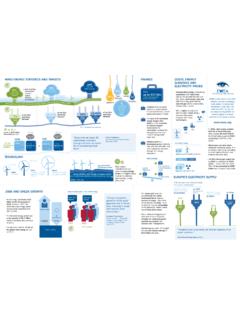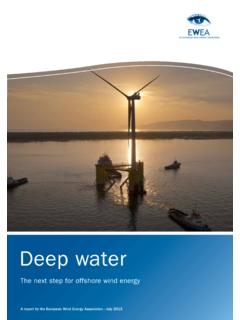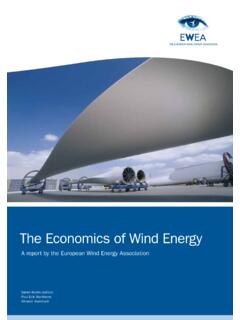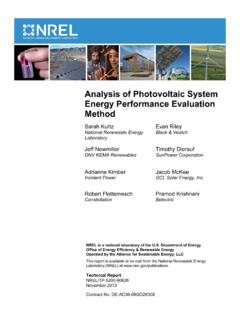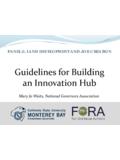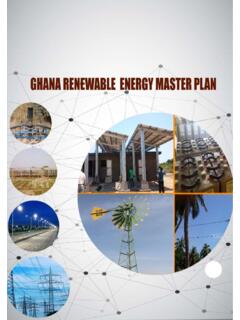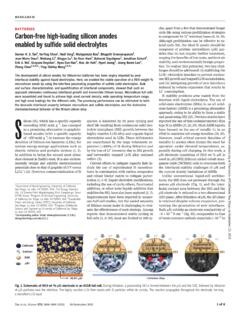Transcription of Economics of Wind Energy - The European Wind Energy ...
1 The Economics of wind EnergyA report by the European wind Energy AssociationS ren Krohn (editor)Poul-Erik MorthorstShimon AwerbuchText and analysis: Soren Krohn, CEO, Soren Krohn Consulting, Denmark (editor); Dr. Shimon Awerbuch, Financial Economist,Science and Technology Policy Research, University of Sussex, United Kingdom; Professor Poul Erik Morthorst, RisoeNational Laboratory, Denmark. Dr. Isabel Blanco, former Policy Director, European wind Energy Association (EWEA), Belgium; Frans Van Hulle, Technical advisor to EWEA, Belgium, and Christian Kjaer, Chief Executive, EWEA, also contributed to this report. Project coordinator: Sarah CliffordCover photo: LM Glasfi berDesign: memory of Dr. Shimon Awerbuch (1946-2007)The Economics of wind EnergyBy the European wind Energy AssociationMarch 2009 THE Economics OF wind ENERGY4 Contents Executive Summary.. 8 Introduction ..241 Basic cost components of wind Energy .
2 Overview of main cost components .. Upfront/ capital costs.. wind Energy Investments in EU-27 up to 2030 .. wind Energy investments and total avoided lifetime cost .. The wind turbine.. wind turbine installation and other upfront costs.. Variable costs .. Operation and maintenance costs (O&M) and other variable costs.. Land rent .. wind resource and power generation.. wind speeds and wind power generation a primer.. Understanding wind capacity factors: why bigger is not always better .. wind climate and annual Energy production .. Energy losses .. The cost of onshore wind .. The cost of offshore wind Energy .. Cost of wind power compared to other technologies ..692. The price of wind Energy .. Price determinants for wind Energy .. Project development risks: spatial planning and other public permitting.
3 Project timing risks.. The voltage level .. Contract term and risk sharing .. Electricity tariffs, quotas or tenders for wind Energy .. Electricity regulation in a state of fl ux .. Market schemes for renewable Energy .. Overview of the different RES-E support schemes in EU-27 countries .. Evaluation of the different RES-E support schemes (effectiveness and economic effi ciency)..873. Grid and system integration Issues.. Grid losses, grid reinforcement and grid management.. Intelligent grid management .. Cost of ancillary services other than balancing power.. Providing balancing power to cope with wind variability .. Short-term variability and the need for balancing .. Additional balancing cost .. Additional network cost .. wind power reduces power prices .. Power markets.. wind power s impact on the power markets An example.
4 Effect that reaching the EU 2020 targets could have on power prices .. Effect on power prices of building interconnectors.. Options for handling long-term variability.. 1105 THE Economics OF wind ENERGY4. Energy policy and economic risk .. Current Energy policy risk .. External effects.. Fuel price volatility: a cost to society.. The oil-GDP effect .. 1145. The value of wind Energy versus conventional generation .. Value of wind compared to gas generation: a risk-adjusted approach .. Traditional engineering- Economics cost models.. A modern, market-based costing method for power generation .. Risk-adjusted COE estimates for electricity generating technologies .. 119 Appendix .. 123 References .. 153 THE Economics OF wind ENERGY67 THE Economics OF wind Energy EWEATHE Economics OF wind ENERGY8 Executive SummaryOne of the most important economic benefi ts of wind power is that it reduces the exposure of our econo-mies to fuel price volatility.
5 This benefi t is so sizable that it could easily justify a larger share of wind Energy in most European countries, even if wind were more expensive per kWh than other forms of power genera-tion. This risk reduction from wind Energy is presently not accounted for by standard methods for calculating the cost of Energy , which have been used by public authorities for more than a century. Quite the contrary, current calculation methods blatantly favour the use of high-risk options for power generation. In a situation where the industrialised world is becoming ever more dependent on importing fuel from politically unstable areas at unpredictable and higher prices, this aspect merits immediate is demonstrated in this publication, markets will not solve these problems by themselves because markets do not properly value the external effects of power generation.
6 Governments need to correct the market failures arising from external effects because costs and benefi ts for a household or a fi rm who buys or sells in the market are different from the cost and benefi ts to society. It is cheaper for power companies to dump their waste, in the form of fl y ashes, CO2, nitrous oxides, sulphur oxides and methane for free. The problem is that it creates cost for others, in the form of lung disease, damage from acid rain or global warming. Similarly, the benefi ts of using wind Energy accrue to the economy and society as a whole, and not to individual market participants (the so-called common goods problem).This report provides a systematic framework for the economic dimension of wind Energy and of the Energy policy debate when comparing different power gener-ation technologies. A second contribution is to put fuel price risk directly into the analysis of the optimal choice of Energy sources for power for fuel-price risk when making cost comparisons between various Energy technologies is unfortunately very uncommon and the approach is not yet applied at IEA, European Commission or govern-ment level.
7 This report proposes a methodology for doing so. The methodology should be expanded to include carbon-price risk as well, especially given the European Union s December 2008 agreement to intro-duce a real price on carbon pollution (100% auctioning of CO2 allowances in the power sector) in the Basic cost of wind energyApproximately 75% of the total cost of Energy for a wind turbine is related to upfront costs such as the cost of the turbine, foundation, electrical equipment, grid-connection and so on. Obviously, fl uctuating fuel costs have no impact on power generation costs. Thus a wind turbine is capital-intensive compared to conven-tional fossil fuel fi red technologies such as a natural gas power plant, where as much as 40-70% of costs are related to fuel and O&M. Table gives the price structure of a typical 2 MW wind turbine.
8 Acciona9 THE Economics OF wind ENERGYTABLE : Cost structure of a typical 2 MW wind turbine installed in Europe ( 2006)INVESTMENT ( 1,000/MW)SHARE OF TOTAL COST %Turbine (ex works) ,227100 Note: Calculated by the author based on selected data for European wind turbine installations Operation and maintenance (O&M) costs for onshore wind Energy are generally estimated to be around to c per kWh of wind power produced over the total lifetime of a turbine. Spanish data indicates that less than 60% of this amount goes strictly to the O&M of the turbine and installations, with the rest equally distributed between labour costs and spare parts. The remaining 40% is split equally between insurance, land rental and costs per kWh of wind -generated power, calcu-lated as a function of the wind regime at the chosen sites, are shown in Figure below.
9 As illustrated, the costs range from approximately 7-10 c /kWh at sites with low average wind speeds, to approximately c /kWh at windy coastal sites, with an average of approximately 7c /kWh at a wind site with average wind speeds. The fi gure also shows how installation costs change electricity production : Calculated costs per kWh of wind generated power as a function of the wind regime at the chosen site (number of full load hours). Source: Ris ,100/kW1,400/kWc/kWhLow wind areas1,7001,5002,9002,1002,5001,9002,700 2,300 Medium wind areasCoastal areasNumber of full load hours per year** Full load hours are the number of hours during one year during which the turbine would have to run at full power in order to produce the Energy delivered throughout a year ( the capacity factor multiplied by 8,760).THE Economics OF wind ENERGY10 Figure shows how discount rates affect wind power generation costs.
10 The rapid European and global development of wind power capacity has had a strong infl uence on the cost of wind power over the last 20 years. To illus-trate the trend towards lower production costs of wind -generated power, a case (Figure ) that shows the production costs for different sizes and models of turbines is presented. Due to limited data, the trend curve has only been constructed for Denmark, although a similar trend (at a slightly slower pace) was observed in Germany. The economic consequences of the trend towards larger turbines and improved cost-effectiveness are clear. For a coastal site, for example, the average cost has decreased from around c /kWh for the 95 kW turbine (mainly installed in the mid 1980s), to around c /kWh for a fairly new 2,000 kW machine, an improvement of more than 40% (constant 2006 prices).
